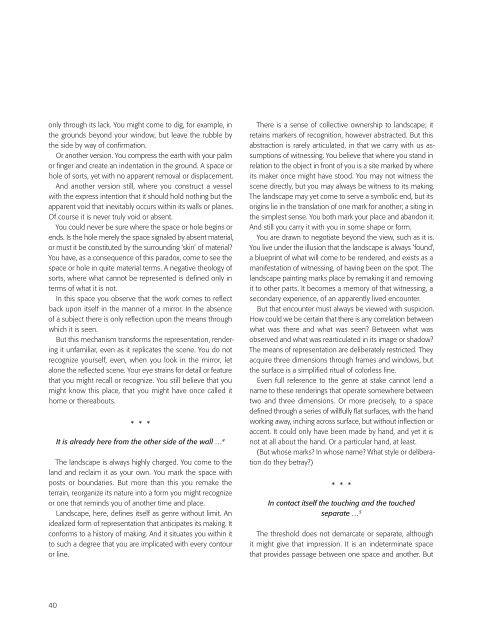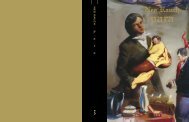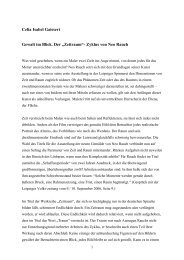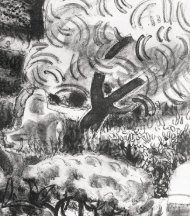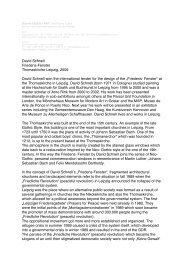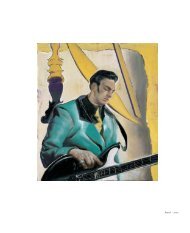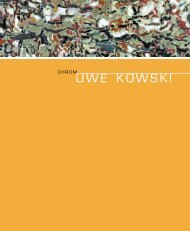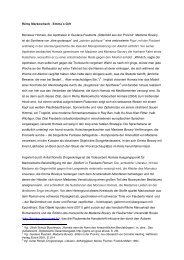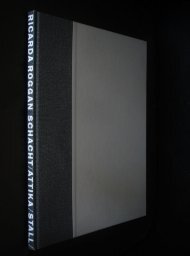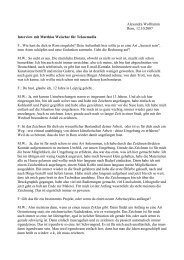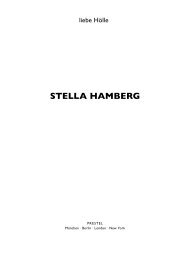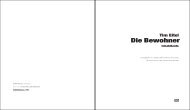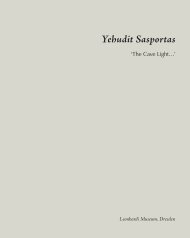YEHUDIT SASPORTAS - Galerie EIGEN+ART
YEHUDIT SASPORTAS - Galerie EIGEN+ART
YEHUDIT SASPORTAS - Galerie EIGEN+ART
You also want an ePaper? Increase the reach of your titles
YUMPU automatically turns print PDFs into web optimized ePapers that Google loves.
only through its lack. You might come to dig, for example, in<br />
the grounds beyond your window, but leave the rubble by<br />
the side by way of confirmation.<br />
Or another version. You compress the earth with your palm<br />
or finger and create an indentation in the ground. A space or<br />
hole of sorts, yet with no apparent removal or displacement.<br />
And another version still, where you construct a vessel<br />
with the express intention that it should hold nothing but the<br />
apparent void that inevitably occurs within its walls or planes.<br />
Of course it is never truly void or absent.<br />
You could never be sure where the space or hole begins or<br />
ends. Is the hole merely the space signaled by absent material,<br />
or must it be constituted by the surrounding ‘skin’ of material?<br />
You have, as a consequence of this paradox, come to see the<br />
space or hole in quite material terms. A negative theology of<br />
sorts, where what cannot be represented is defined only in<br />
terms of what it is not.<br />
In this space you observe that the work comes to reflect<br />
back upon itself in the manner of a mirror. In the absence<br />
of a subject there is only reflection upon the means through<br />
which it is seen.<br />
But this mechanism transforms the representation, rendering<br />
it unfamiliar, even as it replicates the scene. You do not<br />
recognize yourself, even, when you look in the mirror, let<br />
alone the reflected scene. Your eye strains for detail or feature<br />
that you might recall or recognize. You still believe that you<br />
might know this place, that you might have once called it<br />
home or thereabouts.<br />
0<br />
‹ ‹ ‹<br />
It is already here from the other side of the wall … 4<br />
The landscape is always highly charged. You come to the<br />
land and reclaim it as your own. You mark the space with<br />
posts or boundaries. But more than this you remake the<br />
terrain, reorganize its nature into a form you might recognize<br />
or one that reminds you of another time and place.<br />
Landscape, here, defines itself as genre without limit. An<br />
idealized form of representation that anticipates its making. It<br />
conforms to a history of making. And it situates you within it<br />
to such a degree that you are implicated with every contour<br />
or line.<br />
There is a sense of collective ownership to landscape; it<br />
retains markers of recognition, however abstracted. But this<br />
abstraction is rarely articulated, in that we carry with us assumptions<br />
of witnessing. You believe that where you stand in<br />
relation to the object in front of you is a site marked by where<br />
its maker once might have stood. You may not witness the<br />
scene directly, but you may always be witness to its making.<br />
The landscape may yet come to serve a symbolic end, but its<br />
origins lie in the translation of one mark for another; a siting in<br />
the simplest sense. You both mark your place and abandon it.<br />
And still you carry it with you in some shape or form.<br />
You are drawn to negotiate beyond the view, such as it is.<br />
You live under the illusion that the landscape is always ‘found’,<br />
a blueprint of what will come to be rendered, and exists as a<br />
manifestation of witnessing, of having been on the spot. The<br />
landscape painting marks place by remaking it and removing<br />
it to other parts. It becomes a memory of that witnessing, a<br />
secondary experience, of an apparently lived encounter.<br />
But that encounter must always be viewed with suspicion.<br />
How could we be certain that there is any correlation between<br />
what was there and what was seen? Between what was<br />
observed and what was rearticulated in its image or shadow?<br />
The means of representation are deliberately restricted. They<br />
acquire three dimensions through frames and windows, but<br />
the surface is a simplified ritual of colorless line.<br />
Even full reference to the genre at stake cannot lend a<br />
name to these renderings that operate somewhere between<br />
two and three dimensions. Or more precisely, to a space<br />
defined through a series of willfully flat surfaces, with the hand<br />
working away, inching across surface, but without inflection or<br />
accent. It could only have been made by hand, and yet it is<br />
not at all about the hand. Or a particular hand, at least.<br />
(But whose marks? In whose name? What style or deliberation<br />
do they betray?)<br />
‹ ‹ ‹<br />
In contact itself the touching and the touched<br />
separate … 5<br />
The threshold does not demarcate or separate, although<br />
it might give that impression. It is an indeterminate space<br />
that provides passage between one space and another. But<br />
Innenseiten-05.indd 40 21.05.2007 0:18:31 Uhr


